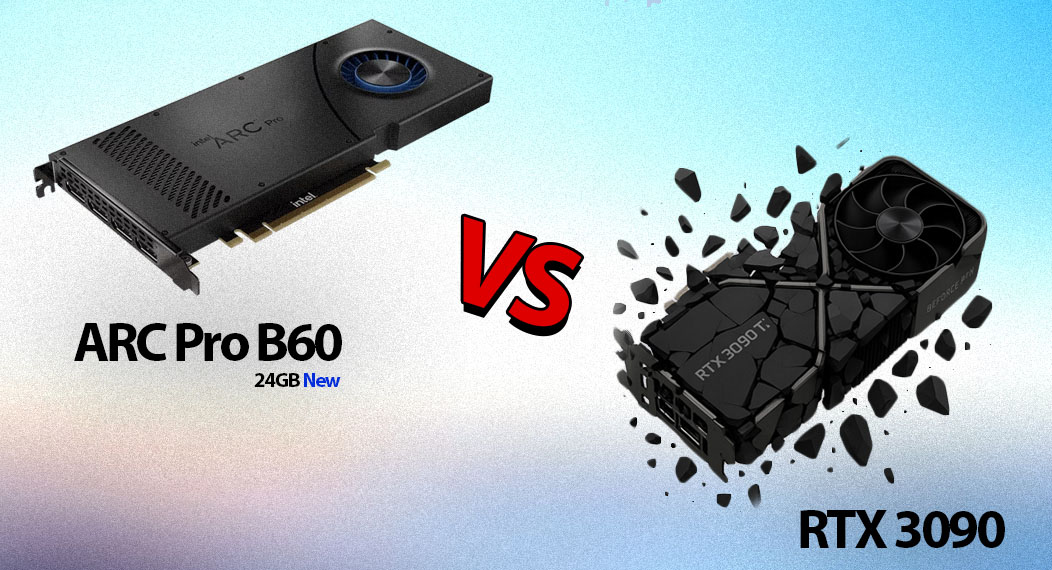Forget Used RTX 3090s – Intel’s 24GB Arc Pro B60 Could Be the Better Buy for Local LLM

Intel is poised to expand its professional graphics lineup with the Arc Pro Battlemage series, confirmed for a reveal at Computex. Among the anticipated offerings, one model, the Arc Pro B60, is set to feature a significant 24GB of VRAM. This development is particularly noteworthy for the burgeoning community of enthusiasts running large language models (LLMs) locally, where VRAM capacity is often the most critical bottleneck.
Specifications and GPU Architecture
According to information emerging alongside Intel’s teasers, the Arc Pro B60 24GB will be based on the BGM-G21 GPU. Crucially, it’s expected to retain a 192-bit memory bus, identical to what a consumer-grade B580-class card would feature. This strongly suggests the 24GB capacity will be achieved using a clamshell configuration with standard GDDR6 memory, likely operating at speeds that would yield a memory bandwidth around 456 GB/s – similar to what a 12GB Arc B580 might offer, just with doubled capacity. Shipping documents and rumors over the past year had hinted at a 24GB “Developer Edition” or a high-VRAM B580 variant, and this Arc Pro B60 appears to be the professional realization of that concept.
Challenges with the “Pro” Branding
While the 24GB VRAM on the Arc Pro B60 is a compelling prospect for local LLM enthusiasts, the “Pro” branding introduces some practical considerations. Intel’s professional GPU SKUs – like the previous-generation Arc Pro A60 – have traditionally seen more limited retail availability than their consumer-focused counterparts. This distinction can affect accessibility for hobbyists and small-scale developers, who may find it harder to source these cards through mainstream channels, often facing higher prices or limited distribution compared to the more readily available “B” series gaming variants.
Design and Market Positioning
Intel’s teaser images depict a blower-style cooler, indicative of a single-slot design akin to its predecessor, the Arc Pro A60. While the “Pro” designation targets workstation users, the specifications, particularly the VRAM, make it an intriguing option for technical hobbyists focused on local AI if the price is right. The Alchemist-based Arc Pro A60 notably used the ACM-G12 GPU rather than the top-tier ACM-G10, so the B60 leveraging the BGM-G21 (presumably the Battlemage equivalent of an x580/x570 class GPU) aligns with this strategy.
Implications for Local LLM Inference
For local LLM inference, memory bandwidth is a vital performance metric directly impacting token generation speed, especially as models and context windows grow. The Arc B580 12GB has already demonstrated respectable performance, achieving around 38 tokens per second with 7B models using Vulkan, competitive with an NVIDIA RTX 3060 12GB but with better power efficiency. The Arc Pro B60, while likely sharing a similar core GPU configuration and thus similar per-core compute, will unlock the ability to run significantly larger models, such as 32B parameter models quantized to 4-bit (which typically require around 19GB VRAM), or smaller models with much larger context lengths, thanks to its 24GB VRAM pool.
With an expected memory bandwidth of approximately 456 GB/s, the Arc Pro B60 would theoretically sit above the NVIDIA RTX 4060 Ti 16GB (288 GB/s) and approach the RTX 4070 (504.2 GB/s). Given the RTX 4070 can achieve roughly 80 tokens/second with Llama 3 8B Q4_K_M, one might cautiously anticipate the Arc Pro B60 to deliver performance somewhere in the range of 50-60 tokens/second for similar 4-bit quantized 7-8B models, pending driver maturity and software optimization for Intel’s XMX units via OpenVINO, SYCL (supported in PyTorch 2.7), or Vulkan.
Pricing and Value Considerations
The ultimate appeal of the Arc Pro B60 24GB for the LLM enthusiast will inevitably hinge on its price. While the consumer-grade Intel Arc B580 12GB retails for around $300 new, with secondhand units dipping lower, hopes for the 24GB Arc Pro B60 landing in a similarly aggressive sub-$500 bracket – perhaps $350 to $450 – might be optimistic. The “Pro” designation typically carries a price premium, and its predecessor, the Arc Pro A60, still hovers around the $500 mark. While a sharply priced B60 24GB would be a phenomenal value proposition, its professional target market may lead Intel toward a higher MSRP. This pricing will be critical when comparing it to existing 24GB VRAM alternatives: used NVIDIA RTX 3090 cards, which often sell for $950 to $1000, or a dual RTX 3060 12GB setup costing $550 to $600 for two cards.
Comparative Specifications Overview
Here’s how the Intel Arc Pro B60’s anticipated specifications might compare to some current and rumored 24GB solutions:
| Feature | Intel Arc Pro B60 | NVIDIA RTX 3090 | NVIDIA RTX 4090 | NVIDIA RTX 5090 | Dual RTX 3060 12GB |
|---|---|---|---|---|---|
| VRAM | 24GB GDDR6 | 24GB GDDR6X | 24GB GDDR6X | 24GB GDDR7 | 2x 12GB GDDR6 |
| Memory Bus | 192-bit | 384-bit | 384-bit | 512-bit | 192-bit |
| Bandwidth | ~456 GB/s | 936.2 GB/s | 1.01 TB/s | ~1.79 TB/s | 336 GB/s |
| Llama 3 8B Q4 | ~50-60 t/s (Estimate) | ~108 t/s | ~127 t/s | ~208 t/s | ~35-40 t/s |
| Price | $500+ (Speculative) | $1000 (Used) | $2400+ | $3700+ | $600 (for two) |
| Software Ecosystem | OpenVINO, Vulkan, SYCL | CUDA | CUDA | CUDA | CUDA |
Conclusion: A Strategic Opportunity for Intel
The potential for an aggressively priced 24GB card from Intel could significantly lower the barrier to entry for running larger LLMs locally. It offers a pathway for users who are currently VRAM-constrained by cards like the RTX 3060 12GB or RX 6700 XT 12GB, without needing to step up to the much higher cost of an RTX 3090/4090 or manage a multi-GPU setup solely for VRAM aggregation. The single-slot blower design is also beneficial for users considering multi-GPU configurations in the future, should Intel’s drivers and software frameworks mature to effectively scale LLM workloads across multiple Arc Pro cards.
Intel has an opportunity here to capture mindshare and market share among AI developers and enthusiasts, particularly those looking for alternatives to NVIDIA’s CUDA ecosystem. Continued improvements in OpenVINO, SYCL, and Vulkan support will be crucial. While raw performance may not match top-tier offerings, the Arc Pro B60’s strength could lie in its VRAM capacity per dollar.
Enthusiasts will be keenly awaiting official pricing and independent benchmarks following the Computex announcement. If Intel delivers on the promise of accessible 24GB VRAM, the Arc Pro B60 could become a cornerstone for budget-conscious local LLM inference rigs.
Leave a Reply
No comments yet.




